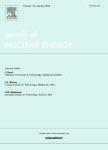版权所有:内蒙古大学图书馆 技术提供:维普资讯• 智图
内蒙古自治区呼和浩特市赛罕区大学西街235号 邮编: 010021

作者机构:Xi An Jiao Tong Univ Dept Nucl Sci & Technol State Key Lab Multiphase Flow Power Engn Xian 710049 Peoples R China Univ Michigan Dept Nucl Engn & Radiol Sci Ann Arbor MI 48109 USA Brigham Young Univ 350 Clyde Bldg Provo UT 84602 USA
出 版 物:《ANNALS OF NUCLEAR ENERGY》 (核能纪事)
年 卷 期:2020年第145卷
页 面:106987-106987页
核心收录:
学科分类:08[工学] 0827[工学-核科学与技术]
基 金:Chinese Scholarship Council US DOE Office of Nuclear Energy's Nuclear Energy University Programs (NEUP)
主 题:DHR Integral reactor Station Black-Out Heat removal
摘 要:The Integral, Inherently Safe Light Water Reactor ((IS)-S-2-LWR) is an innovative Pressurized Water Reactor (PWR) concept being developed by a multi-institutional team led by Georgia Tech and in collaboration with Westinghouse, under the Department of Energy s Nuclear Energy University Programs Integrated Research Projects (DOE NEUP IRP). The University of Michigan leads the design of the thermal-hydraulic and passive safety systems, in collaboration with Westinghouse and Bringham Young University. The I2S-LWR features an integral primary system configuration and is more conducive to the implementation of inherent safety features by eliminating potential accidents. In this paper, a novel passive Decay Heat Removal System (DHRS), is presented, consisting of a primary loop, an intermediate loop and a cooling tower loop. This passive system is designed to remove the I2S-LWR decay heat in the case of emergency heat removal transients, without the need for external power or operator action. The proposed DHR uses atmosphere as ultimate heat sink, to achieve indefinite decay heat removal. In this paper, firstly, the design of primary and secondary DHRS heat exchangers is optimized. Then the DHR heat removal characteristics are studied using the best-estimate thermal hydraulic code RELAP5. In addition, CFD simulations have been performed in order to investigate the DRHS helical coil primary heat exchanger performance with different coil pipe arrangements, and optimize its design. The performance of the proposed DHRS concept is investigated in case of a Station Black-Out (SBO) scenario. Operation of two, three and four DHRS trains is studied respectively. The results show that three out of four DHRS trains are sufficient to indefinitely remove the core decay heat successfully during a SBO, and keep the reactor in a safe state without the need of any other auxiliary active system. (C) 2019 Elsevier Ltd. All rights reserved.